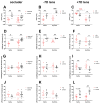GABAB Receptor Activation Affects Eye Growth in Chickens with Visually Induced Refractive Errors
- PMID: 36979369
- PMCID: PMC10046083
- DOI: 10.3390/biom13030434
GABAB Receptor Activation Affects Eye Growth in Chickens with Visually Induced Refractive Errors
Abstract
This study aims to explore the role of GABAB receptors in the development of deprivation myopia (DM), lens-induced myopia (LIM) and lens-induced hyperopia (LIH). Chicks were intravitreally injected with 25 µg baclofen (GABABR agonist) in one eye and saline into the fellow eye. Choroidal thickness (ChT) was measured via OCT before and 2, 4, 6, 8, 24 h after injection. ChT decreased strongly at 6 and 8 h after baclofen injection and returned back to baseline level after 24 h. Moreover, chicks were monocularly treated with translucent diffusers, -7D or +7D lenses and randomly assigned to baclofen or saline treatment. DM chicks were injected daily into both eyes, while LIM and LIH chicks were monocularly injected into the lens-wearing eyes, for 4 days. Refractive error, axial length and ChT were measured before and after treatment. Dopamine and its metabolites were analyzed via HPLC. Baclofen significantly reduced the myopic shift and eye growth in DM and LIM eyes. However, it did not change ChT compared to respective saline-injected eyes. On the other hand, baclofen inhibited the hyperopic shift and choroidal thickening in LIH eyes. All the baclofen-injected eyes showed significantly lower vitreal DOPAC content. Since GABA is an inhibitory ubiquitous neurotransmitter, interfering with its signaling affects spatial retinal processing and therefore refractive error development with both diffusers and lenses.
Keywords: GABA receptor; choroidal thickness; dopamine; eye growth; lens induced hyperopia; myopia.
Conflict of interest statement
The authors declare no conflict of interest.
Figures






Similar articles
-
Effects of intravitreally and intraperitoneally injected atropine on two types of experimental myopia in chicken.Exp Eye Res. 2007 Feb;84(2):266-74. doi: 10.1016/j.exer.2006.09.019. Epub 2006 Nov 13. Exp Eye Res. 2007. PMID: 17101130
-
Comparative effects of posterior eye cup tissues from myopic and hyperopic chick eyes on cultured scleral fibroblasts.Exp Eye Res. 2013 Feb;107:11-20. doi: 10.1016/j.exer.2012.11.005. Epub 2012 Nov 28. Exp Eye Res. 2013. PMID: 23201112
-
Choroidal and scleral mechanisms of compensation for spectacle lenses in chicks.Vision Res. 1995 May;35(9):1175-94. doi: 10.1016/0042-6989(94)00233-c. Vision Res. 1995. PMID: 7610579
-
Choroidal thickness and ocular growth in childhood.Surv Ophthalmol. 2021 Mar-Apr;66(2):261-275. doi: 10.1016/j.survophthal.2020.06.008. Epub 2020 Jul 4. Surv Ophthalmol. 2021. PMID: 32634443 Review.
-
Temporal integration of visual signals in lens compensation (a review).Exp Eye Res. 2013 Sep;114:69-76. doi: 10.1016/j.exer.2013.02.014. Epub 2013 Mar 5. Exp Eye Res. 2013. PMID: 23470505 Free PMC article. Review.
Cited by
-
Inhibitory effect of Zhujing Pill on myopia progression: Mechanistic insights based on metabonomics and network pharmacology.PLoS One. 2024 Dec 3;19(12):e0312379. doi: 10.1371/journal.pone.0312379. eCollection 2024. PLoS One. 2024. PMID: 39625993 Free PMC article.
-
Gut Microbiota Profiles in Myopes and Nonmyopes.Invest Ophthalmol Vis Sci. 2024 May 1;65(5):2. doi: 10.1167/iovs.65.5.2. Invest Ophthalmol Vis Sci. 2024. PMID: 38691091 Free PMC article.
-
Effects of computer-generated patterns with different temporal and spatial frequencies on choroidal thickness, retinal dopamine and candidate genes in chickens wearing lenses.Front Med (Lausanne). 2024 Dec 10;11:1469275. doi: 10.3389/fmed.2024.1469275. eCollection 2024. Front Med (Lausanne). 2024. PMID: 39720655 Free PMC article.
-
Animal modeling for myopia.Adv Ophthalmol Pract Res. 2024 Jun 5;4(4):173-181. doi: 10.1016/j.aopr.2024.06.001. eCollection 2024 Nov-Dec. Adv Ophthalmol Pract Res. 2024. PMID: 39263386 Free PMC article. Review.
-
The potential role of amino acids in myopia: inspiration from metabolomics.Metabolomics. 2024 Dec 15;21(1):6. doi: 10.1007/s11306-024-02207-x. Metabolomics. 2024. PMID: 39676079 Review.
References
-
- Troilo D., Smith E.L., 3rd, Nickla D.L., Ashby R., Tkatchenko A.V., Ostrin L.A., Gawne T.J., Pardue M.T., Summers J.A., Kee C.-S., et al. IMI—Report on Experimental Models of Emmetropization and Myopia. Investig. Ophthalmol. Vis. Sci. 2019;60:M31–M88. doi: 10.1167/iovs.18-25967. - DOI - PMC - PubMed
Publication types
MeSH terms
Substances
LinkOut - more resources
Full Text Sources
Medical

